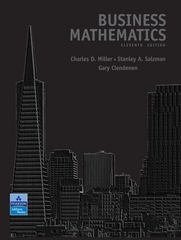Question
4. What is the present value of the net tax-shield of debt if the current market value of the firm is $10 million, its value
4. What is the present value of the net tax-shield of debt if the current market value of the firm is $10 million, its value if unlevered would be $8 million, and the present value of bankruptcy and agency costs is $500,000?
a. $1,500,000
b. $2,000,000
c. $2,500,000
d. None of the above are correct.
5. What is the market value of common equity under the NOI approach? The firm has an expected net operating income of $5,000 with $4,000 of debt (market value). Assume that the overall capitalization rate is 20%.
a. $5,000
b. $20,000
c. $21,000
d. $25,000
6. Which of the following statements regarding the net operating income approach is incorrect?
a. The overall capitalization rate, kO, is constant.
b. The cost of debt funds, ki, is constant.
c. The required return on equity, ke, is constant.
d. The total value of the firm is unaffected by changes in financial leverage.
7. Which of the following statements regarding the total value principle is incorrect?
a. The total value principle allows for corporate borrowing and excludes personal borrowings via arbitrage.
b. The total value principle must hold or else arbitrage will take place and then its presence will cause the value to remain constant regardless of the capital structure.
c. The total value does not change because the underlying profit and risk of the firm are with its operations, which do not change when the financing changes.
d. Modigliani and Miller, in their original position, advocate that the total value of the firm is identical regardless of the financing mix.
8. Two identical firms exist except that Firm A uses no debt and Firm B uses some debt. The total value of Firm A is less than the total value of Firm B, but you own 2% of Firm B. Based on the arguments by Modigliani and Miller regarding the total value principle, what should you do?
a. Buy 2% of Firm A with funds from "shorting" your shares in Firm B. Submit a press release that the two firms should be worth identical values. This will cause Firm A to rise in value and leave you extra funds for investment.
b. You should borrow enough funds to equal the difference in firm value, purchase shares of Firm A with these funds, and sell your shares in Firm B. This will leave extra funds for an investment of your choice.
c. Sell your shares, personally borrow 2% of the quantity of firm debt, and purchase 2% of Firm A. This will leave extra funds for an investment of your choice.
d. Sell enough of your shares (Firm B) to purchase 2% of Firm A. This will leave extra funds for an investment of your choice.
Step by Step Solution
There are 3 Steps involved in it
Step: 1

Get Instant Access to Expert-Tailored Solutions
See step-by-step solutions with expert insights and AI powered tools for academic success
Step: 2

Step: 3

Ace Your Homework with AI
Get the answers you need in no time with our AI-driven, step-by-step assistance
Get Started


